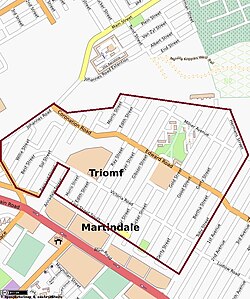
Back Sophiatown Afrikaans Sophiatown German Sophiatown Esperanto Sophiatown Spanish Sophiatown Finnish Sophiatown French Sophiatown ID Sophiatown Italian Sophiatown NSO
Sophiatown
Sof'town, Kofifi, Triomf | |
|---|---|
 | |
| Coordinates: 26°10′36″S 27°58′54″E / 26.1767°S 27.9816°E | |
| Country | South Africa |
| Province | Gauteng |
| Municipality | City of Johannesburg |
| Main Place | Johannesburg |
| Area | |
| • Total | 0.95 km2 (0.37 sq mi) |
| Population (2011)[1] | |
| • Total | 5,371 |
| • Density | 5,700/km2 (15,000/sq mi) |
| Racial makeup (2011) | |
| • Black African | 26.8% |
| • Coloured | 25.8% |
| • Indian/Asian | 5.1% |
| • White | 41.4% |
| • Other | 0.8% |
| First languages (2011) | |
| • Afrikaans | 44.5% |
| • English | 31.9% |
| • Tswana | 4.7% |
| • Zulu | 4.5% |
| • Other | 14.4% |
| Time zone | UTC+2 (SAST) |
| Postal code (street) | 2092 |
Sophiatown /soʊˈfaɪətaʊn/, also known as Sof'town or Kofifi, is a suburb of Johannesburg, South Africa. Sophiatown was a poor multi-racial area and a black cultural hub that was destroyed under apartheid. It produced some of South Africa's most famous writers, musicians, politicians and artists, like Father Huddleston, Can Themba, Bloke Modisane, Es'kia Mphahlele, Arthur Maimane, Todd Matshikiza, Nat Nakasa, Casey Motsisi, Dugmore Boetie, and Lewis Nkosi.
Rebuilt as a whites-only area under the name of Triomf ("Triumph") in the 1960s, in 2006 it was officially returned to its original name. Sophiatown was one of the oldest black areas in Johannesburg and its destruction represented some of the excesses of South Africa under apartheid.[2]
- ^ a b c d "Sub Place Sophiatown". Census 2011.
- ^ Otzen, Ellen (11 February 2015). "The town destroyed to stop black and white people mixing". BBC News. Retrieved 1 December 2017.

